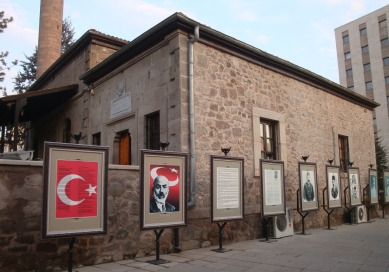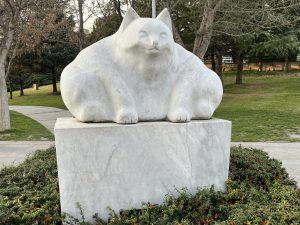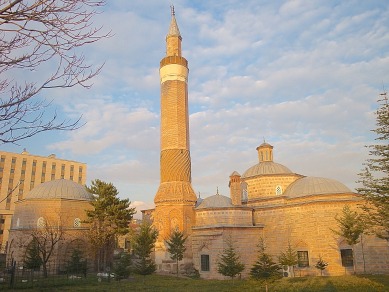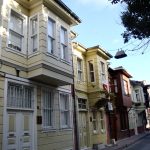“In front of the hamam”
Until recently a run-down, neglected part of old Ankara, Hamamönü has been given a complete Odunpazarı-style makeover with its old Ottoman housing stock completely rebuilt and some of it given new uses.
While some displaced locals may not be very happy about what has happened, it’s clear that this is all part of a plan which will make the entire area from Ulus up to the Hisar into a much more inviting area for tourism. Ankara used to be a place where visitors stopped briefly to view the must-see Museum of Anatolian Civilisations before moving speedily on again. The renovation of Hamamönü has been part of a gentrification project aimed at turning it into a destination in its own right.
Work has now advanced into the Hamamarkası (Behind the Hamam) area where catering to henna nights, bachelor parties, weddings and baby showers is now big business. And the hamam after which the area is named? It’s the Karacabey Hamamı, founded in 1440, which has been restored as part of the general regeneration effort.
 Although the main reason to take a turn around this district is to admire the restored Ottoman houses. there are also a few specific attractions to look out for.
Although the main reason to take a turn around this district is to admire the restored Ottoman houses. there are also a few specific attractions to look out for.
The first is the small museum in memory of Mehmet Akif Ersoy, composer of the İstiklal Marşı (Independence March), Turkey’s national anthem.
The museum consists of a cottage equipped with mannequins that sits right beside the Taceddin Tekkesi, the dervish lodge where he wrote the march. Dating back to 1610, this lodge was greatly expanded in 1845 by Sultan Abdülmecid who added a mosque and burial area to turn it into a proper complex. Notice the reused Roman columns of the portico. In 2024 the cottage was closed for renovation.
A large and well-kept park stretches out beside the museum. Perhaps its most striking feature is the statue of a particularly fat white Ankara cat. 
Wandering around Hamamönü you may also stumble upon the lovely Karacabey (İmaret) Cami, an unusual find in a city often thought of as “new” since it dates back to 1427 and the reign of Sultan Murad II. It was commissioned by Celalettin Karacabey who died in 1444 during the assault on Varna. He is buried in a tomb beside the mosque that was added during the reign of Sultan Selim III. Unusually, the name of the mosque architect is known – he was one Ahmed bin Ebu Bekir. The single minaret is beautifully decorated both with tiles and with carvings taken from ancient sites. The mosque faces the entrance to Hacettepe University. Note in particular its lovely original wooden doors. Look closely at the portico and you’ll see that Roman pillars, capitals and other pieces of masonry have been extensively reused. Inside, the mosque is smaller than you’d expect. The architecture is in the early Ottoman style perfected in Bursa.

Along Talatpaşa Caddesi
The main road skirting Hamamönü to the north is Talatpaşa Caddesi which heads east from Opera. Before you get to Hamamönü on the south side of it, to the north you could divert into the largely abandoned old Yahudi (Jewish) Mahallesi whose grand synagogue is invisible behind high walls, identifiable only by Art Nouveau stars of David on the wrought-iron gate. Facing it two fine mansions have been restored.
If you keep walking along Talatpaşa Caddesi pass the turn-offs on the right into Hamamönü itself you will eventually come to Kestane Caddesi on the left. If you walk along it you will come to the only Sinan work in Ankara, the Cebani Ahmed Paşa Cami, constructed in 1565-66 with a tomb for the founder that mirrors the decoration of the portico. The mosque has a design not dissimilar to that of the Karacabey Cami. Of a dervish tekke that once existed nearby there is no longer any trace.
Cebani Ahmed Paşa Cami opens onto Ulucanlar Caddesi and across a small park and to the left you’ll find the Ulucanlar Cezaevi Müzesi (Prison Museum, closed Mondays, admission TL20), a sobering “attraction” where you visit the cells that once held a number of high-profile prisoners such as Bülent Ecevit, Yılmaz Güney, Nazım Niket and Deniz Geçmiş. Most were confined in dormitories although Ecevit (later a prime minister) was kept in a four-bed cell nicknamed accordingly the “Hilton”. It’s grim enough to see the gallows where men were executed, even grimmer to learn how young some of those hanged were at the time of their execution.
Sleeping
There are a few small hotels here but they are likely to suffer from noise either from Talatpaşa Bulvarı or the cafes and bars.
Transport info
Hamamönü is within walking distance of Ulus, Opera and the Hisar.
Nearby areas


